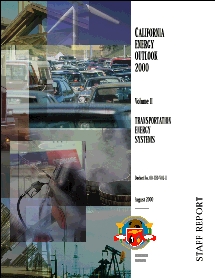
"Without water and the ability to move it efficiently over hundreds of miles --to cities, suburbs, farms and factories -- California would be unrecognizable as the fertile, vibrant state it is today. Already, scientists say, there are clear signs that global warming will put that vital flow in jeopardy. The Sierra Nevada snowpack, a natural reservoir that stores 40 percent of the state's water supply in the winter and gradually releases it in the spring and summer, is shrinking. The mountains are getting more rain and less snow, and the snowpack is melting at least a week earlier than it did before World War II. Sea level has risen half a foot at the Golden Gate..."
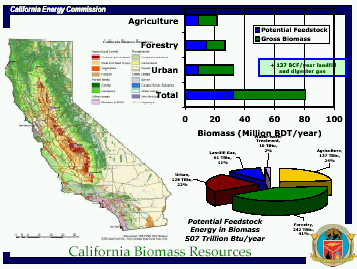 Biomass to Bioenergy: California Policy and Action
Martha Krebs, Deputy Director for R&D, California Energy Commission, Briefing for Swedish Delegation [2007 January 11]
Biomass to Bioenergy: California Policy and Action
Martha Krebs, Deputy Director for R&D, California Energy Commission, Briefing for Swedish Delegation [2007 January 11]
"Current and Future Status of Bioenergy (biopower & biofuel) in California"Public Interest Energy Research Program (PIER), by Martha Krebs, Ph.D., Deputy Director, Energy R & D Division, California Energy Commission, to ACS Committee on Environmental Improvement [2006 September 9]
Graphic overview of energy statistics in CaliforniaEconomic, Energy, and Environmental Benefits of Concentrating Solar Power in California, by L. Stoddard, J. Abiecunas, and R. O'Connell, Black & Veatch, Overland Park, Kansas; in Collaboration with the Interfaith Environmental Council and the Coalition on the Environment and Jewish Life of Southern California, Los Angeles, California [2006 April]
This study provides a summary assessment of concentrating solar power (CSP) and its potential economic return, energy supply impact, and environmental benefits for the State of California. Emphasis was placed on in-state economic impact in terms of direct and indirect employment created by the manufacture, installation, and operation of CSP plants. The environmental impact of CSP relative to natural gas fueled counterparts was studied. The value of CSP as a hedge against natural gas price increases and volatility was also analyzed.Phil Angelides' Clean California Plan [pdf] [2006]
So far we haven't heard much about upcoming electricity price increases. Note the percentage of PG&E generation from natural gas in 2004.
Annual report of actual electricity purchases for Pacific Gas and Electric in 2004, by PG&E [2005 April]
California State Treasurer Phil Angelides’ Green Wave Initiative [2004 February]
Power Content Label Annual report of actual electricity purchases for
Pacific Gas and Electric in 2004Energy Resources PG&E Actual Power Mix Eligible Renewable 12% Biomass and Waste 5% Geothermal 2% Small Hydroelectric 3% Solar 0% Wind 1% Coal 3% Large Hydroelectric 17% Natural Gas 48% Nuclear 21% Other 0% TOTAL 100% For all but one category, the percentage PG&E projected was within 5 percentage points of the actual percentage. Natural gas was 48 percent of PG&E's generation, rather than the predicted 42 percent, due to lower hydroelectric conditions, two nuclear refueling outages and higher than predicted retail sales. For specific information about this electricity product, contact Pacific Gas and Electric Company. For General Information about the Power Content Label, contact the California Energy Commission at 1.800.555.7794 or www.energy.ca.gov/consumer.
"California State Treasurer Phil Angelides launched the Green Wave environmental investment initiative in February 2004, calling on the California Public Employees’ Retirement System (CalPERS) and the California State Teachers’ Retirement System (CalSTRS) to implement a four-pronged investment strategy to bolster their financial returns, create jobs, clean up the environment, and combat global warming."
Why California Should Develop Its Solar Energy Resource [1.1 mb, pdf], by Solar Energy Industries Assn. (SEIA); Solar Thermal Power Division, The DOE Concentrating Solar Power (CSP) Program; SunLab, a virtual laboratory comprising groups at Sandia National Laboratories and the National Renewable Energy Laboratory (NREL) [2003 September 8]
"California can add another engine for its economy by developing its solar energy resource. The economic benefits to California far exceed the cost to develop its clean and renewable resource...Approximately one third of one percent of California’s land could generate all of the state’s current electricity needs."
Loss of Iraqi Oil Could Have Big Effect on State The country accounts for 28% of California's crude imports. Pump prices could rise in war. by Elizabeth Douglass, LA Times Staff Writer [February 10, 2003]
"A Mideast war would be likely to disrupt oil markets nationwide, but the shock could be bigger in California, where more than 8% of the state's already tight oil supplies come from Iraq -- twice the percentage of the U.S. as a whole.It is perhaps surprising that an early sign of the impending global energy crisis surfaced in a place as technologically advanced, innovative and wealthy as California. How did it happen? Will others be affected? Was it just market manipulation by the likes of Enron? Was it really a temporary incident?"In fact, Iraq is the biggest single source of foreign oil in California, accounting for about 28% of imports. That's partly because the type of "sour" crude it produces is a good match for refineries owned by ChevronTexaco Corp., the state's No. 1 buyer of Iraqi oil...."
"U.S. natural gas supplies could fall as much as 10% in as little as six months from now. The drop could be close to double this amount by the time it bottoms. If this happens, it will jolt the U.S. economy far worse than the 1973 Oil Embargo. And unfortunately, there is no quick fix to this supply crisis.Matthew R. Simmons, Simmons & Company International [May 23, 2002]
"The challenge has also been compounded by the $43 billion in long-term contracts the state locked in to buy 20 years worth of power. While state law called on contract negotiators to get as much renewable power as they could, they ended up relying heavily on natural-gas fired plants. More than 90 percent of the contracts are with such plants, according to a report by the California Public Interest Research Group."California's eyes are on Texas' model for creating power; Davis Expected to Embrace Similar Alternative Energy Plan
San Jose Mercury News [July 26, 2001]
"The generation industry in the USA has gone on a mammoth dash-for-gas without properly checking [whether] the gas needed was in fact available - which it isn't.Are you getting ready for the shock that this is going to create? The winter of 2001 was just the snow on the tip of the iceberg."Natural gas production in the USA and Canada has peaked and is about to decline rapidly, the first major natural gas province in the world to do so."
Today's Outlook for Supply and Demand for Electricity in California [Daily]
More Than California's Problem -- Governor Gray Davis [May 16]
S. David Freeman has been hired by Governor Davis to be his chief energy adviser. Let's see what he can do. [April 18]
Methane Madness: A Natural Gas Primer. "In 2000 the wellhead price of natural gas skyrocketed 400%. This was the sharpest energy price increase the nation had ever seen, outdoing even the oil spikes of the 1970s. The price hikes hit hard, hammering homeowners, business, and industry, contributing to rolling blackouts in California, weighing on the stock market, and unleashing a frenzy of new drilling. It was, one expert wrote, a "train wreck." So what comes next? [April]
How We Got into the California Energy Crisis by Jan Hamrin, Center for Resource Solutions, and William Marcus, JBS Energy, Inc. Note in the paper how the utilities went to FERC to block Renewables. FERC said the utilities didn't have to buy them unless they were the cheapest. So the Integrated Resource Plan (BRPU) for California was thrown out. [February]
See a list of stories on the California Energy Crisis at CNN.
A Lost Opportunity That Worsened Crisis: Utilities and federal regulators shut the door on renewable power in California by Susan Sward, S F Chronicle [Feb 12, 2001]
California's high energy cost has been characterized as the result of price gouging. Such possibilities cannot be overlooked:
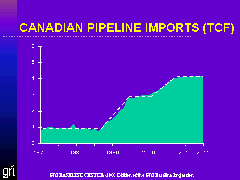 In order to lower emissions, electricity in California over the past few years has been increasingly produced from natural gas, a fuel source that is in decline. This is not to say that there is no more natural gas to be found. It means that there has been a shift from a buyer's market to a seller's market.
In order to lower emissions, electricity in California over the past few years has been increasingly produced from natural gas, a fuel source that is in decline. This is not to say that there is no more natural gas to be found. It means that there has been a shift from a buyer's market to a seller's market.
If natural gas extraction is really in decline in the USA (see US Natural Gas Supply Update, by Jean Laherrère, February 2001), where does California's natural gas come from? Increasingly, not from domestic sources. Canada exports 60% of its supply to the USA, and as Canadian gas fields produce less, supply to the USA will decline. Production in some Gulf of Mexico gas fields is decreasing 25%-50% per year. Obviously these conditions will lead to price increases for fuel. Only subsidies (taxes or inflation) can preserve unrealistically low prices for electricity. More to the point, soon natural gas will too valuable to waste as a fuel for electricity generation and other sources will have to be found.
The value of natural gas is not simply its role as a fuel. Many people are not aware that "[h]elium, present in relatively high concentrations in only a few natural gas fields, is released to the atmosphere and wasted when the natural gas is burned as fuel. See: The Federal Helium Program: The Reaction Over An Inert Gas, by James E. Mielke, Science Policy Research Division, SPR, October 9, 1996. "From 1929 until 1960 the federal government was the only domestic helium producer. In 1960, Congress amended the Helium Act to provide incentives to natural gas producers for stripping natural gas of its helium, for purchase of the separated helium by the government, and for its long-term storage." Can we stop the overexploitation of natural gas before it is too late to preserve its valuable in such ways?
 |
| Volume II [pdf, 2.661 Mb] |
As of February 2001, some components of this report have been published. One related staff report, California Natural Gas Analysis and Issues, concludes: "The substantial North American natural gas resources can meet the nation's demand for at least the next 50 years, at current consumption levels." This conclusion can be challenged on the following points:
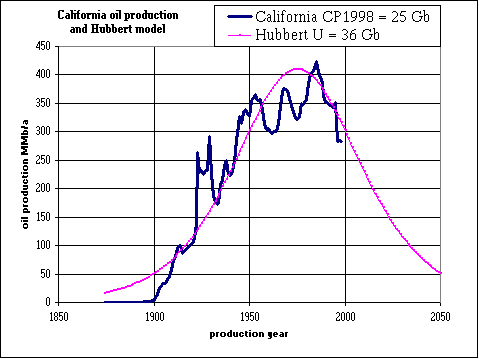 |
| Historic Oil Production in California ... peaked in 1985 ... |
In Volume II of the staff's draft report, the only mention of a future peak in global oil production is tangential:
While this statement suggests that the authors considered an oil peak, this consideration has had no evident impact on their report, which does not even contain a representation of a Hubbert curve. The only relevant projection (of demand, their Figure 1.2) depicts only an unlimited future, and no rollover.
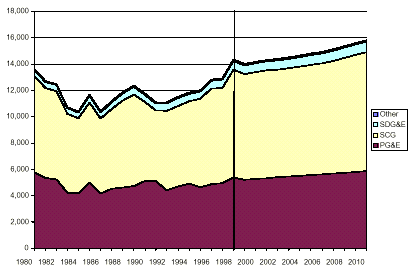 |
| Natural Gas Consumption by Utility from California Energy Demand 2000-2010 |
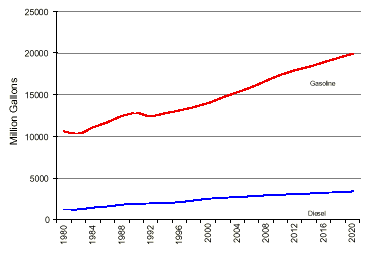 |
| Figure 1.2 Historical (1980-1998) and Projected (1999-2020) On-Road Gasoline and Diesel Demand for California |
The report will address:
A comprehensive assessment of the petroleum and alternative fuels markets will provide the foundation for addressing critical transportation needs and policy issues for the state.
Fuels and Transportation Committee of the Energy Commission (decision-makers):
"A lawyer by profession, he brings to the Energy Commission 25 years of experience in the energy field. Chairman Keese earned his Juris Doctorate at Loyola University, Los Angeles, where he also studied engineering as an undergraduate."Chairman Keese's initial energy activities included work on the legal framework for the developmentof geothermal resources in the Geysers area of California and on collaborative agreements for the development of British North Sea petroleum reserves. He also did substantial work on California's initial Superfund Legislation. He returned to the energy field, representing California's Solar Energy Industry Association for 12 years while also representing California's dentists and other business interests."
You can e-mail Chairman Keese through his executive assistant, Pamela Lovelace, PLovelac@energy.state.ca.us
"Since 1993, Commissioner Moore of Albion, California, has been a consulting economist. From 1993 to 1994, he served on the State Board of Landscape Architects. He was Chief Economist for the Landmark Land Co. from 1989 to 1991, and was Deputy Director for local government for the Governor's Office of Planning and Research from 1985 to 1991. He was elected Supervisor in the County of Monterey, serving from 1976 to 1985. He was also on the Seismic Safety Commission from 1978 to 1985.You can e-mail Mr. Moore through his executive assistant, Karen Van Egdon, kvanegdo@energy.state.ca.us"In 1972, Commissioner Moore received a BS Degree in geology and natural resources from Humboldt State University, Arcata, California. In 1974, he received a master's degree in land economics from the Ecology Institute at the University of California, Davis. He is a candidate for a Ph.D. in land economics at Cambridge University, England.
"His memberships include the Atlantic Economic Society, the Big Sur Foundation, and the Aircraft Owners and Pilots Association."
Commission Management
Project Managers
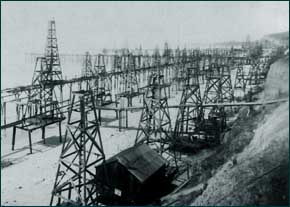 |
| View of oil derricks on the beach near Santa Barbara circa 1900. Photo credit: California History Room California State Library, Sacramento |